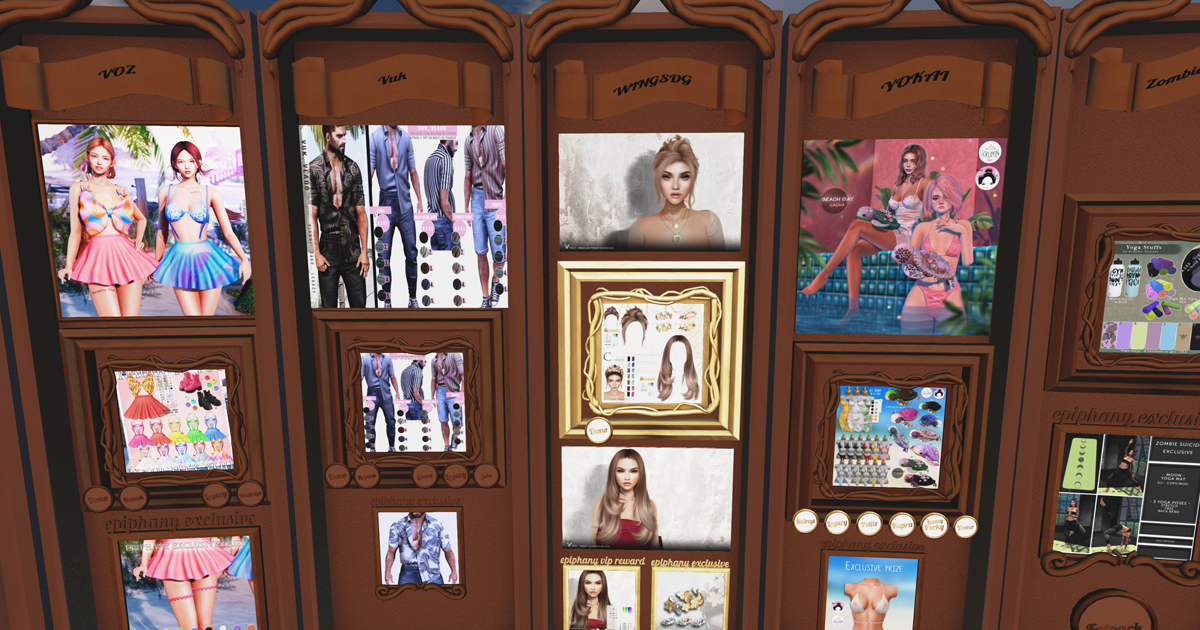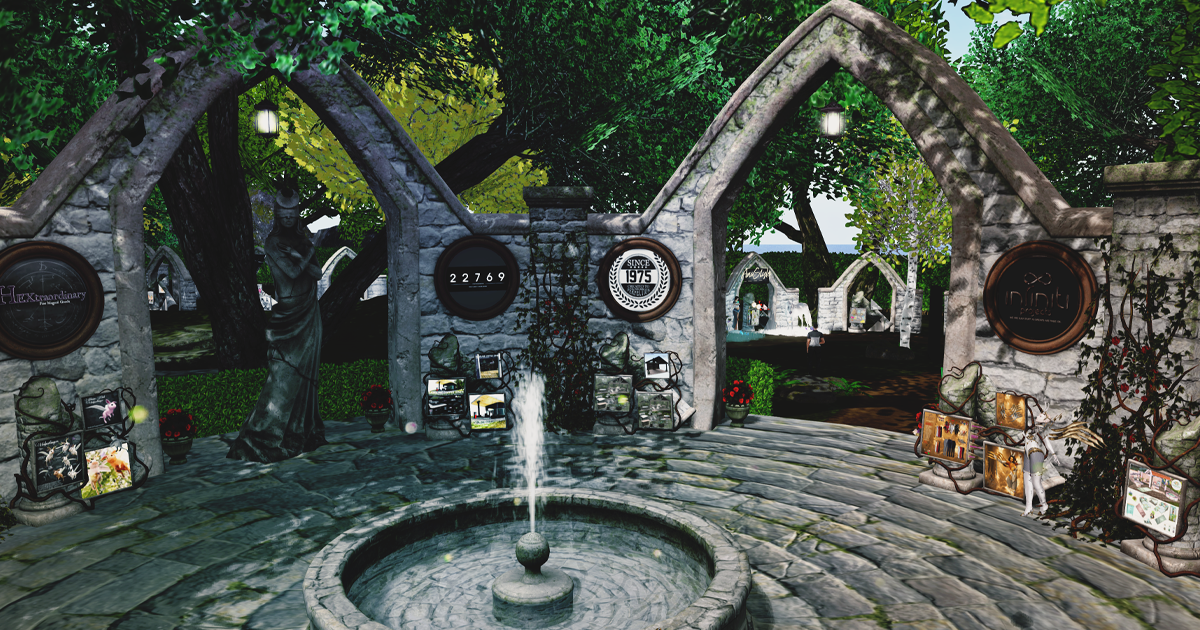The era of Gacha machines in Second Life has come to an end. Although I was not aware of it, Lindens Lab has decided to discontinue them due to the legality of gambling in various countries they operate in. The Gacha system has been a topic of debate for years, with opinions split on whether it qualifies as a form of gambling.
According to Glimne (2019), gambling refers to the act of betting or risking something of worth with an awareness of the potential risks involved and the expectation of obtaining a benefit, typically on the outcome of an uncertain event, game, or competition, which may be determined by chance, luck, or unforeseen circumstances arising from the bettor’s erroneous judgement.
To be blunt, anyone who cannot recognize Gacha machines as a type of gambling is not being realistic. The fact that you receive an item with each pull does not negate the fact that it involves gambling.
Upon returning to Second Life, Gacha was a novel concept to me. My sister Saki brought me to the Epiphany event, which resembled a gaming arcade, and I was surprised to see people engaging in gambling to obtain virtual products.
However, I soon realized how addicting Gacha machines can be when I found myself spending more than I intended, all for the chance to own a rare item. Gacha creators are masters at enticing people to keep pulling the lever, and it can become a dangerous cycle for those prone to addictive behavior.

The Epiphany was established in 2015, and from their website so does The Arcade.
A commentator remarked that in the past, Gacha machines were exclusive to well-attended events featuring unique and innovative products. However, things changed when some creators began exploiting this market by introducing Gacha products for ordinary items and placing machines at every fashion event.
Gacha was a personal favorite of mine for decorating my Second Life home. The items often had better quality and lower prim counts than regular products, and I appreciated the ability to find unique and intricate designs.
Although I enjoyed Gacha, I didn’t frequently participate in the machines due to my limited budget. After paying the region’s tier, I would have occasionally spend nearly 5000L at events like the Epiphany or the Arcade, which were the two primary Gacha events I looked forward to attending.
I mostly purchased my Gacha products from the Second Life Marketplace, where I also sell my duplicates. It is a more cost-effective option and there is no element of chance involved. You simply purchase the items you desire.
It is disheartening to think that many of the Gacha products listed on the Marketplace may have come from individuals who spent a significant amount of Lindens. I have often wondered if some people only played Gacha machines to resell the items and make money on Second Life.
It took me a considerable amount of time to remove all the Gacha products from my two houses and skyboxes when I decided to redecorate my house without doing a parcel return. The time-consuming process left me disenchanted with Gacha. Though I did manage to use some Gacha products for my pool area, which I purchased from MP. However, a few days ago, I stumbled upon a Gacha that piqued my interest. It had a rare backdrop and several poses that caught my eye, but unfortunately, none of them were available on MP yet. So, I decided to try my luck at the event, thinking that I couldn’t possibly lose. Sadly, I ended up getting the same pose three times, which is a common occurrence in Gacha and something that I find frustrating.
People are drawing comparisons between Gacha machines and gumball machines on social media platforms. Gumball machines are inexpensive and contain one low-value item in each ball.
When people used to go to gumball machines, they were hoping to get a random-colored piece of gum or a cheap plastic ring. It was not something that was addictive or costly.
Someone said that Trompe L’oeil Gacha is the kind of Gacha that can be likened to a gumball machine. It had a low wager of 25L per pull, and all the items were the same, but with a different color. However, Gacha machines, in general, can be addictive and expensive.

The Gacha Garden
One disadvantage of Gacha machines is that sometimes one item is useless without obtaining the rare item. For instance, a pool or a house might be the rare item, while other items would be the tile surroundings. If you end up with duplicates of the tiles and never obtain the rare item, the chances of reselling the useless tiles are slim.
Occasionally, the rare item in a Gacha set appeared to be nonsensical. I found myself questioning why a particular item was rare, especially when all the items seemed to have the same value. I presume that the rare item’s appeal and what makes it addictive is the rarity factor, which necessitates having one rare item in every set, no matter how arbitrary it may seem.
In my experience playing Gacha machines, it never appeared to be equitable. However, is gambling ever truly impartial?
Obtaining a rare Gacha item is a game of chance. I’ve had instances where I got the rare on my third pull or even twice in a row, but it was never from the popular brands.
According to some vendors, Gacha machines can be adjusted to affect the win rate. However, it is unclear how many vendors actually adjust them fairly to improve the odds of getting a rare or reduce the number of useless duplicates. Like casinos, loot boxes, and Gacha machines exist to make profits, and their owners control who wins and how much.
Creators who solely rely on selling Gacha items may face more challenges compared to businesses that have Gacha items as part of their product line. Flickr is currently filled with Gacha-related posts such as pictures of Gacha sales, inquiries, and surveys about what to offer next.
What if the Gacha items were sold as regular products, providing buyers with the freedom to purchase what they want? This would eliminate concerns over accidentally deleting ‘no-copy’ items. Additionally, some products already offer the choice to buy either a copy or no-copy version, with the latter typically being more expensive. While it may require more effort to set up, offering this option would be a viable solution.
In a discussion I was following, a creator made the point that it is the responsibility of customers to support the creators whose products they enjoy so that they can continue producing them. Creators don’t just create for the sake of it; they need a stable income to sustain themselves. Many of them have either given up their real-life jobs or never had one, so they can focus on their Second Life business. Customers buying their products is what allows them to generate a steady income to keep creating.
“It IS your job as a customer to support the creator you like the product of, so they can continue making them for you. Creators don’t create out of just kindness and love. We need income, we need money. Many of us either quit RL jobs, or never get one so we can dedicate ourselves to the SL business BECAUSE OF the customers buying them & creating a stable income for us to be able to dedicate.”
One could argue that it is not the responsibility of consumers to purchase products, especially when they are overpriced in the Second Life economy. It’s important to remember that money is not an infinite resource, and customers typically have to earn it in real life before they can spend it in virtual worlds. As a customer, my job is simply to buy what I want, when I want, and when I have the Lindens to do so.
Creators don’t have to rely on Gacha to sell their products. Their main responsibility is to design and offer high-quality merchandise at a fair price to keep customers interested in their brand. However, it’s worth noting that poor customer service can cause customers to stop purchasing from a store.
The aspect of the end of Gacha that excites me the most is the elimination of the need to pursue rare items, especially considering the exorbitant prices they often command. The prospect of having an equal opportunity to purchase items that were previously reserved for a select few, whether they were lucky or big spenders, is very attractive to me.
Some people on social networks believe that the end of Gacha machines will cause Second Life to fail. However, I disagree with this belief and believe that the removal of Gacha machines will not have a significant impact on Second Life’s overall success.
My decision to not purchase Gacha products hasn’t affected my spending habits. Second Life has a wide variety of content creators who provide enough products to keep me spending my Lindens. Additionally, there are numerous events that take place frequently, with new ones appearing almost every week.
While Gacha machines were a popular way of selling products in Second Life, they were not the only method available for creators to sell their products. There are other avenues and platforms for creators to showcase and sell their products, which means that the end of Gacha machines is not the end of the world for Second Life residents.
In fact, many content creators have found success selling their products without Gacha machines.
What do you think about creators having to rethink their business after the end of Gacha machines? Do you prefer buying products through Gacha machines or traditional means?
Let’s end this post with a ‘funny’ real life Gacha video.
Poor cats …
Here is some news about the Arcade Gacha, Gacha Guild, To Continue Despite Gacha Ban which shows it is not the end of Second Life.
References
Glimne, D. (2019, February 20). Gambling. Encyclopedia Britannica. https://www.britannica.com/topic/gambling

1 comment
Great article. I never got much into Gacha machines because I hated getting that crappy item – sometimes twice – when the thing I really wanted was right there inside. But I know some people enjoyed it, and appreciate that when you take away something people enjoy they will get upset.
But no-copy + limited number items is a nice idea because it means we can have more unique homes and avatars. And of course we can trade those items. That all still works fine without the gambling aspect.
But yes there should be better protection against accidentally losing items when moving house. I have lost a few no-copy things from parcel return because they were deeded to a group. All of that permissions stuff gets confusing to me!